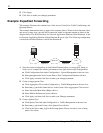
Nokia Network Voyager for IPSO 4.0 Reference Guide 461
6. Click the ATM QoS Descriptors link.
7. In the Existing ATM QoS Descriptors field, click the Delete check box next to the name of
the ATM QoS Descriptor that you want to delete.
8. Click Apply.
The ATM QoS Descriptor disappears from the Existing QoS Descriptors field.
9. Click Save to make your changes permanent.
To associate an ATM QoS Descriptor with an interface and a virtual channel
1. Click Interfaces under Configuration > Interface Configuration in the tree view.
2. Click the appropriate interface link in Physical field.
The physical interface page for the interface you selected appears.
3. Click the ATM QoS Configuration link.
The ATM QoS Configuration page for the physical interface you selected appears.
4. Under Configure a New PVC in the VPI/VCI edit box, enter the virtual path identifier/
virtual channel identifier (VPI/VCI) of the permanent virtual channel (PVC) you want to
configure.
5. Under Configure a New PVC field, click the QoS Descriptor drop-down list and select the
QoS descriptor with which you want to associate the PVC you configured.
Note
You cannot delete or modify a QoS Descriptor that has been associated with a
permanent virtual channel (PVC). You must first disassociate the PVC from the QoS
descriptor. See “To delete an ATM QoS descriptor” for more information.
Note
You can change the QoS configuration of a PVC while it is being used. However, doing
so results in a short break in traffic because the PVC is closed while QoS configuration
values change. Afterward, the system reopens the PVC.
6. Click Apply.
The name of the new PVC and ATM QoS Descriptor with which you associated the PVC
appear in QoS Configured PVCs field.
7. Click Save to make your changes permanent.
Configuring Common Open Policy Server
The Common Open Policy Server (COPS) provides a standard for exchanging policy
information in order to support dynamic Quality of Service (QoS) in an IP (Internet Protocol)
network. This information is exchanged between PDPs (Policy Decision Points) and PEPs


















